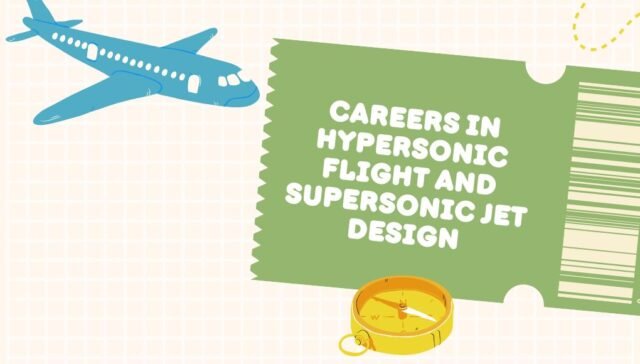The aerospace industry is experiencing a renaissance, with hypersonic flight and supersonic jet design at the forefront of technological advancements. These fields offer a plethora of career opportunities for engineers, researchers, and innovators eager to push the boundaries of speed and performance in aviation.
Entry-level hypersonic flight engineering jobs,
Supersonic jet design internships for students,
Remote aerospace engineering positions in hypersonics,
Supersonic aircraft design job openings in India,
Hypersonic propulsion system engineering careers.
Understanding Hypersonic and Supersonic Flight
Supersonic Flight refers to travel at speeds greater than Mach 1, the speed of sound. Aircraft like the Concorde and military jets have historically achieved these speeds. In contrast, Hypersonic Flight pertains to speeds exceeding Mach 5, presenting unique challenges and opportunities in aerodynamics, propulsion, and materials science.
Career Opportunities in Hypersonic and Supersonic Technologies
The demand for professionals in these cutting-edge fields is escalating. Below is an overview of potential career paths:
1. Aerospace Engineer
Role: Design and develop aircraft and propulsion systems capable of supersonic and hypersonic speeds.
Key Responsibilities:
- Conduct aerodynamic analysis and testing.
- Develop propulsion systems, including scramjets and ramjets.
- Collaborate with multidisciplinary teams to optimize aircraft performance.
Job Prospects:
- NASA’s Hypersonic Airbreathing Propulsion Branch is seeking qualified individuals with expertise in Computational Fluid Dynamics (CFD) for hypersonic propulsion systems.
- Spike Aerospace is looking for experienced CFD engineers to contribute to the development of their next-generation supersonic civilian jet.
2. Computational Fluid Dynamics (CFD) Specialist
Role: Utilize advanced simulations to analyze fluid flow around high-speed aircraft.
Key Responsibilities:
- Develop and validate CFD models for aerodynamic performance.
- Optimize designs to reduce drag and improve stability.
- Collaborate with design teams to integrate simulation results.
Job Prospects:
- Lockheed Martin offers positions for CFD specialists focusing on hypersonic projects.
3. Propulsion Engineer
Role: Design and test propulsion systems for high-speed aircraft.
Key Responsibilities:
- Develop engines capable of sustained hypersonic speeds.
- Conduct performance testing and data analysis.
- Ensure compliance with safety and regulatory standards.
Job Prospects:
- Hermeus is an aerospace company developing hypersonic aircraft and may have opportunities for propulsion engineers.
4. Materials Scientist
Role: Research and develop materials that can withstand extreme temperatures and stresses encountered during high-speed flight.
Key Responsibilities:
- Investigate high-temperature alloys and composites.
- Test material performance under simulated flight conditions.
- Collaborate with engineers to integrate materials into aircraft designs.
Job Prospects:
- Venus Aerospace is developing reusable hypersonic technology and may offer roles for materials scientists.
5. Flight Test Engineer
Role: Oversee and conduct flight tests to validate aircraft performance and safety.
Key Responsibilities:
- Plan and execute test flights for new aircraft designs.
- Analyze flight data to assess performance metrics.
- Ensure adherence to safety protocols during testing.
Job Prospects:
- Stratolaunch is seeking a Chief Engineer to lead the development of an air-launched, high-speed vehicle development program.
Top Universities Offering Courses in Hypersonic and Supersonic Flight
Pursuing specialized education is crucial for a successful career in these fields. Here are some leading institutions offering relevant programs:
-
Purdue University School of Aeronautics and Astronautics
Offers comprehensive programs in aerospace engineering with opportunities to engage in hypersonic research. -
University of Queensland’s Centre for Hypersonics
Recognized as a leading university-based hypersonics research group, focusing on high-speed propulsion and flight systems. -
Texas A&M University
Hosts the University Consortium for Applied Hypersonics, providing resources and research opportunities in hypersonic technologies. -
University of Tennessee
Offers programs with a focus on hypersonic aerodynamic experiments. -
California Institute of Technology (Caltech)
Provides advanced research opportunities in hypersonics and related fields.
Further Reading
To deepen your understanding of hypersonic and supersonic flight, consider exploring the following resources:
-
“Hypersonic Flight Vehicle Design and Performance Analysis”
A comprehensive course covering airbreathing hypersonic flight vehicles, emphasizing propulsion systems. -
“Supersonic & Hypersonic Flight”
An overview of the engineering challenges and advancements in high-speed flight. -
Hermeus
An aerospace company developing hypersonic aircraft, offering insights into current industry developments.
Embarking on a career in hypersonic flight and supersonic jet design places you at the cutting edge of aerospace innovation. With the right education and experience, you can contribute to the next generation of high-speed aviation technologies.














